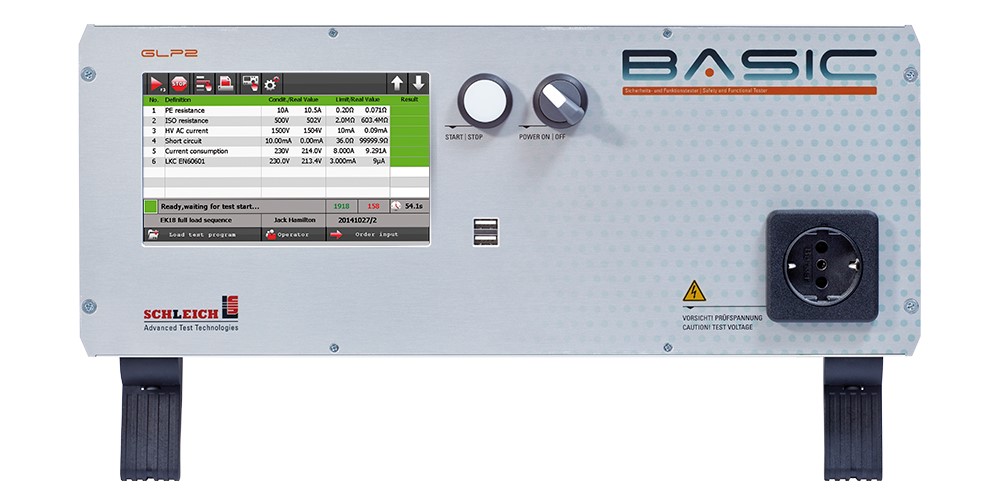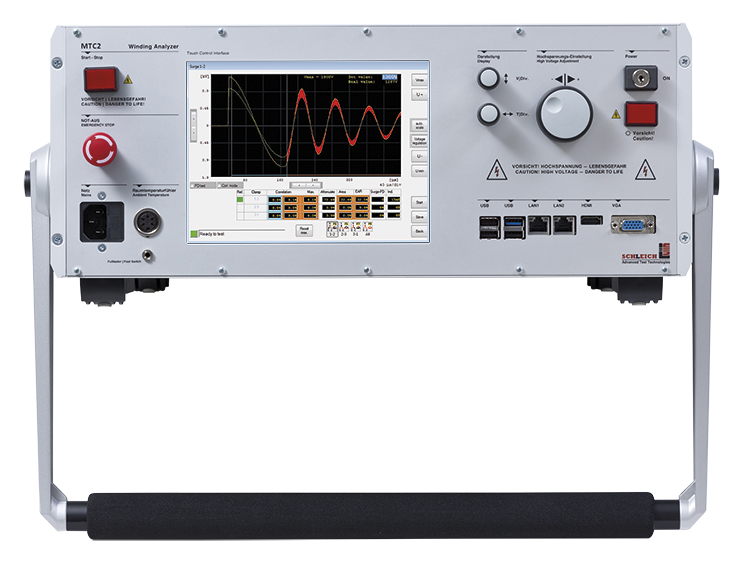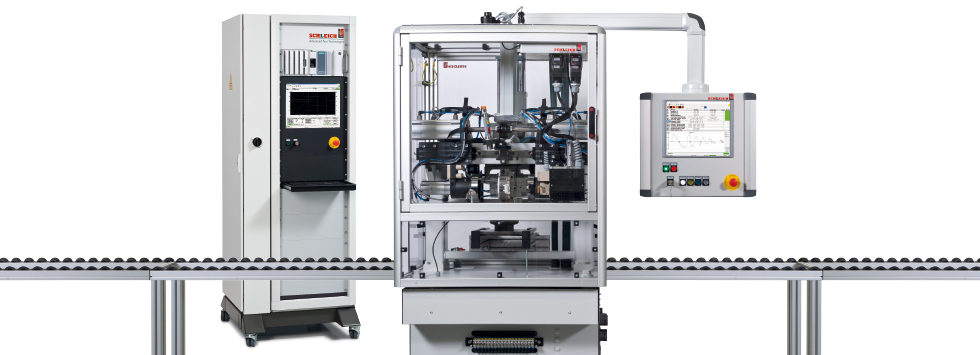Do I feel safe?
Am I doing everything right?
You will know for sure in a few minutes.

Safety tests are mandatory and are part of every final inspection of your electrical product.
Learn the most important facts about the high voltage test AC.
We explain the WHY?, WHERE?, HOW? and also the possible danger!
And if you would like to learn more, you can download even more detailed information at the end of this page free of charge!
RIso or HV AC ?
The principle approach of the high voltage test is very similar to the insulation resistance test. This is because both test methods are concerned with the quality of the insulation.
This can be done by measuring the insulation resistance or by testing the electric strength with high voltage and simultaneously measuring the flowing leakage current.
However, the high voltage test is even more “stressful” (intensive) for the device under test. It reveals insulation weaknesses very sharply. On the other hand, it has the disadvantage that it is not possible to measure the insulation resistance precisely in MΩ or GΩ. It may therefore be useful to perform both tests in succession.
WHY?
Safe insulation is the central protective measure to ensure electrical safety. It ensures that the user does not touch live conductors and that no short circuit can occur between the conductors or to the housing of the equipment. Because if it did occur, a life-threatening current could flow through the user if he or she touched the housing. Obviously, the protective earth conductor should ensure that this does not happen. But in the worst case it could also be defective. And it would also only be an evasion of the effect, not of the cause.
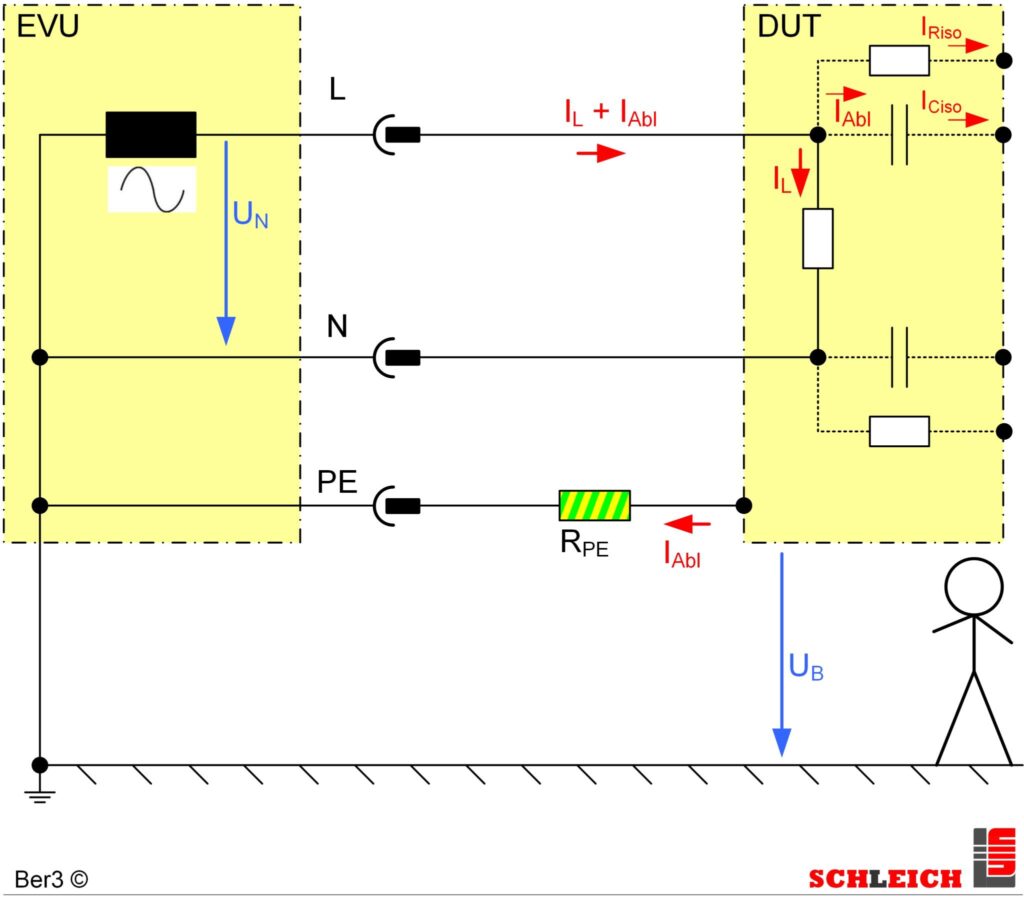
In order to guarantee all this, the insulation must work perfectly! And this must be proven and documented by you in a high voltage test before the electrical product is delivered.
This test is a routine test. This means that every piece, i.e. every single electrical product you put on the market, must undergo a high voltage test.
WHERE?
Basically, there must be good insulation between current-carrying conductors or between these and housing parts. Typically, this is done by insulating the electrical conductors against dangerous contact, i.e. covering them with an insulating material. But this protective sheath must be removed at the latest when the electrical conductor is connected to other electrical components. At these points, the insulation is guaranteed over a safe distance. It is then a matter of safety distances through clearance and creepage distances.
In addition, current-carrying conductors can also be insulated from each other, e.g. by means of casting compounds, insulating foils or solids.
When is which type of insulation used?
This always has to do with the design of the electrical product, the type of specification such as high temperature or mechanical load etc.
Now it is certainly understandable that insulations in a luminaire, an electric iron, an electric motor or a high-voltage insulator in a power station have very different requirements and designs.
From this diversity, quite complex electrotechnical insulation structures result from case to case.
HOW?
Since the insulation has “something to do with the voltage”, the test is carried out with a defined test voltage level. This can be ramped up or applied directly to the device under test at its full magnitude.
The aim is to measure the current through the insulation. Because it is the evaluation criterion for the insulation. It must not be greater than a specified maximum current.
The upper limit of the current can vary greatly from product to product. In the standards there is little or nothing to be found about this limit. And there is a good reason for this – because the amount of current depends heavily on the capacitive component in the insulation.
This test is not mandatory for all electrical products. However, it may well be required for the certification of the electrical product in the type test. If it is required during manufacture, it is a routine test. This means that every piece, i.e. every single electrical product you put on the market, necessarily requires a high voltage test with AC.
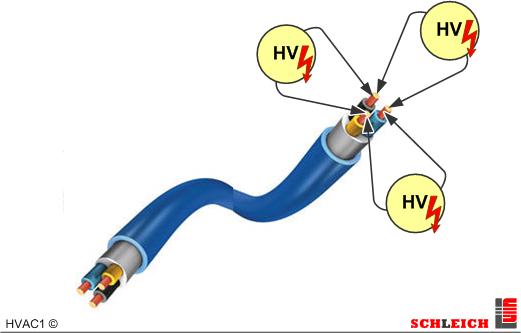
Often the high voltage strength is measured one after the other between all conductors involved. These can be combined groups of conductors or individual conductors and of course the housing or housing parts. It quickly becomes clear that the test can and must be carried out at a wide variety of locations, depending on the complexity of the electrical product.
This could be done by scanning the test points with a test probe – an approach that can quickly turn out to be lengthy and costly.
For 25 years, complex tests have therefore always been carried out automatically at any test points via the SCHLEICH-typical matrix, which is fully programmable:
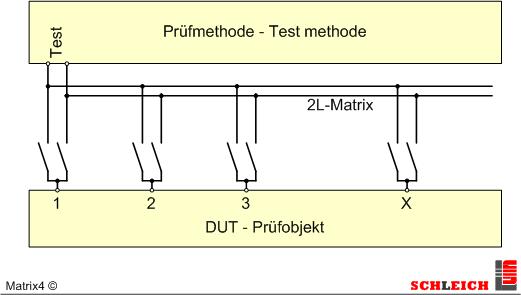
SCHLEICH switching matrixes switch flexibly in 2- and 4-wire technology. Especially 4-wire technology is of great importance in automated systems and plants. It guarantees a safe contact control of the test voltage and thus process stability.
| Test paramters | typical norm values | SCHLEICH | from standard to customized |
| Minimum required test voltage | 1,000 – 3,000 V AC | 50 bis 100,000 V AC |
| max. permissible test current | 1 – 10, 50 ,100 mA | 0,1 – 5,000 mA |
| minimum test duration | 1 s | from 0.1 s to 1 month |
| start-up ramp | off; 1 s – 1 min | off; from 0.5 s to 1 month |
| down ramp | off; 1 s – 1 min | off; from 0.5 s to 1 month |
| voltage profiles | off; in 5 steps | off; in any number of steps with any profile steps |
With this range of requirements, it is of course ideal to use a test device that covers as many of the world’s standards as possible.
That is SCHLEICH’s strength.
The TEST CURRENT?
An insulation always consists of an insulation resistance and a capacitor? Why a capacitor? Was that even built in? …

The test always takes place between two electrical conductors/poles. In an abstract way, these two poles form two metal plates facing each other. Between them is the insulation. And this construction corresponds to that of a capacitor. As a result, the whole insulation structure therefore also behaves strongly capacitive.
The high voltage test AC is performed with alternating voltage. This causes a current dependent on the frequency of the test voltage to flow in the capacitive part of the insulation. The level of the leakage current is proportional to the size of the capacitance.
These are physical factors that have nothing to do with good or bad insulating properties of the device under test. They and of course the standard specify the maximum permissible current.
The decisive factor is now the power of the high-voltage source. It must be able to supply the required current. Otherwise, the high voltage test would not be feasible.
The DANGER?
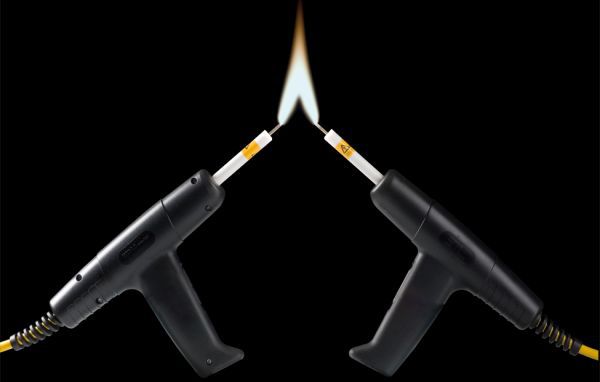
If an alternating current of less than 3 mA flows through the human body, it is classified as non-hazardous.
If a high-voltage source can only supply a maximum of 3 mA, it is therefore considered to be safety-limited and non-hazardous. Special protective measures are not necessary in this case.
But a current of 3 mA is practically nothing for most high voltage tests. Many electrical products require a significantly higher test current due to the capacitive effect. As already mentioned: this is not a knock-out verdict for the test object – but dangerous for the operator. This is because the high voltage source is often designed for 100 mA test current. Appropriate protective measures are then absolutely necessary.
This includes:
- electrically isolated high voltage
- Enclosing of the test station
- Safety test pistols
- Two-hand start with corresponding safety relay
- Test cage or test cabin – double-circuit monitored with approved safety relays and, if necessary, also a safe guard locking
- Compliance with performance level PLe, SIL3, Kat4 …
Performance Level PLe, SIL3, Kat 4 …
The demands on safety engineering are correspondingly high for a test current greater than 3 mA. The relevant international standards must be complied with worldwide.
SCHLEICH test devices meet these requirements!
It should be noted that there is a wide variety of test devices on the international market which look like a supposed bargain, but do not comply with the legally required safety regulations of EN50191/VDE0104!
All set? Want more details?
Our mission – know-how, know-how, know-how… Those who understand the test methods with technical and normative certainty will get the most out of their test device.
– Dipl. Ing. Martin Lahrmann
Yes – tell me more. I want maximum security for our customers, our company and myself.
Send me more detailed information from the SCHLEICH test method handbook.
GLP1-g
PE conductor, insulation, high voltage and function testing deviceThe smallest safety tester in the world!
- PE/GB-resistance testers
- insulation resistance testers – IR
- high voltage testers AC/DC
- safety & function testers
- 50+ device configurations – combining up to 9 test methods in one device
- PLe, SIL3, Kat4 safety circuit (depending on device variant and degree of risk)
- table-top unit or 19″ rack mounting
- ½ 19″ or 19″ format
GLP2-BASIC
Protective conductor, insulation, high voltage, leakage current and function tester- insulation Resistance testers – IR
- high voltage testers AC/DC
- “All in one” testers
- safety & function testers
- app. 40 device variants – combined from up to 21 test methods
- PLe, SIL3, Kat4 safety circuit (depending on device variant and degree of risk)
- network
- protocol & label printing
- scanner …
- Technology Package for even more ergonomics
- table-top unit or 19″ rack mounting
GLP2-MODULAR
Combination tester with up to 25 test methods- “All in one”
- safety testers
- safety & function testers
- modular combination of more than 25 test methods possible
- up to 250 test connections
- large switch matrix modules for all kind test methods
- PLe, SIL3, Kat4 Safety circuit (depending on device variant and degree of risk)
- network
- protocol & label printing
- scanner …
- Technology Package for even more ergonomics
GLP3
Unlimited class leading test technology.The TOP-Class of testing and measuring technology for safety and functional testing.
- “All in one”
- safety & function testers
- for complex projects
- for complex automation
- for the highest demands
- modular combination of more than 30 test methods
- up to 350 test connections
- large switch matrix modules for all kind test methods
- PLe, SIL3, Kat4 safety circuit
- Windows 10®
- network
- protocol & label printing
- industry 4.0
- interfaces to MES, ERP, SPS …
MTC2
Surge tester with 6, 12, 15, 25, 30, 40 or 50 kVThe state of the art winding tester.
- surge test plus standard-compliant partial discharge measurement
- resistance
- insulation resistance
- high voltage DC plus polarization index / DAR
- high voltage AC
ideal for service, production, automation, quality control, laboratory, R&D …
MTC3
Winding tester fully automatic for automation, laboratory ...Reliable winding testing for production, research and quality.
▪ standard motors
▪ special motors
▪ automotive drives
▪ transformers
▪ coils …
▪ ALL-IN-1 with over 20 test methods
▪ in-line partial discharge testing
▪ interfaces for automation such as PROFINET, EtherCAT, TCP/IP …
▪ interfaces to ERP, MES and CAQ systems …




